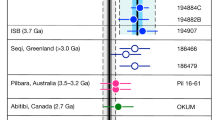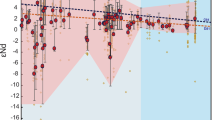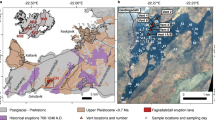Abstract
Ratios of non-volatile elements such as zirconium, niobium (Nb) and tantalum (Ta) in the unfractionated Earth are commonly assumed to be similar to those in the class of meteorites known as chondrites1. However, the Nb/Ta ratio of the Earth’s major silicate reservoirs—the crust and mantle—is subchondritic, hinting at the existence of a complementary reservoir with high Nb/Ta (refs 2, 3). Eclogites, which are high-pressure metamorphic rocks that often form in subduction zones, can contain the mineral rutile (titanium dioxide) with high Nb/Ta. They have therefore been inferred to constitute this complementary reservoir2. More recent evidence from natural samples, however, suggests that residual eclogites have low Nb/Ta, which is confirmed by experiments3,4,5,6. Here, we present the Nb and Ta concentrations and hafnium (Hf) isotope compositions of rutiles from eclogite fragments that were entrained from the subcontinental lithospheric mantle in kimberlite melts. Rutiles with high 176Hf/177Hf ratios generally have subchondritic Nb/Ta (<19.9 (refs 3, 7)), similar to undisturbed melt residues of broadly basaltic precursors. On the other hand, rutiles with suprachondritic Nb/Ta ratios have low 176Hf/177Hf, suggesting Hf addition from a fluid or melt ultimately derived from ancient (≥2.9 Gyr), chemically modified (metasomatized) subcontinental lithospheric mantle, which has similarly low 176Hf/177Hf (ref. 8). Our results suggest that eclogites are unlikely to represent the high Nb/Ta reservoir; instead, the high Nb/Ta signatures of some eclogites are probably generated by metasomatism during long-term residence in the subcontinental lithospheric mantle.
This is a preview of subscription content, access via your institution
Access options
Subscribe to this journal
Receive 12 print issues and online access
$259.00 per year
only $21.58 per issue
Buy this article
- Purchase on Springer Link
- Instant access to full article PDF
Prices may be subject to local taxes which are calculated during checkout


Similar content being viewed by others
References
Taylor, S. R. Chondritic Earth model. Nature 202, 281–282 (1964).
Rudnick, R. L., Barth, M., Horn, I. & McDonough, W. F. Rutile-bearing refractory eclogites: Missing link between continents and depleted mantle. Science 287, 278–281 (2000).
Münker, C. et al. Evolution of planetary cores and the Earth–Moon system from Nb/Ta systematics. Science 301, 84–87 (2003).
Rapp, R. P., Shimizu, N. & Norman, M. D. Growth of early continental crust by partial melting of eclogite. Nature 425, 605–609 (2003).
Schmidt, M. W., Dardon, A., Chazot, G. & Vannucci, R. The dependence of Nb and Ta rutile-melt partitioning on melt composition and Nb/Ta fractionation during subduction processes. Earth Planet. Sci. Lett. 204, 415–432 (2004).
Pfänder, J. A., Münker, C., Stracke, A. & Mezger, K. Nb/Ta and Zr/Hf in ocean island basalts—implications for crust-mantle differentiation and the fate of Niobium. Earth Planet. Sci. Lett. 254, 158–172 (2007).
Weyer, S., Münker, C., Rehkämper, M. & Mezger, K. Determination of ultra-low Nb, Ta, Zr and Hf concentrations and the chondritic Zr/Hf and Nb/Ta by isotope dilution analyses with multiple collector ICP-MS. Chem. Geol. 187, 295–313 (2002).
Griffin, W. L. et al. The Hf isotope composition of cratonic mantle: LAM-MC-ICPMS analysis of zircon megacrysts in kimberlites. Geochim. Cosmochim. Acta 64, 133–147 (2000).
Zack, T., Kronz, A., Foley, S. F. & Rivers, T. Trace element abundances in rutiles from eclogites and associated garnet mica schists. Chem. Geol. 184, 97–122 (2002).
Becker, H., Jochum, K. P. & Carlson, R. W. Trace element fractionation during dehydration of eclogites from high-pressure terranes and the implications for element fluxes in subduction zones. Chem. Geol. 163, 65–99 (2000).
Xiong, X. L., Adam, T. J. & Green, T. H. Rutile stability and rutile/melt HFSE partitioning during partial melting of hydrous basalt: Implications for TTG genesis. Chem. Geol. 218, 339–359 (2005).
Foley, S. F., Tiepolo, M. & Vannucci, R. Growth of early continental crust controlled by melting of amphibolite in subduction zones. Nature 417, 837–840 (2002).
Klemme, S., Blundy, J. D. & Wood, B. J. Experimental constraints on major and trace element partitioning during partial melting of eclogite. Geochim. Cosmochim. Acta 66, 3109–3123 (2002).
Münker, C., Wörner, G., Yogodzinski, G. & Churikova, T. Behaviour of high field strength elements in subduction zones: Constraints from Kamchatka-Aleutian arc lavas. Earth Planet. Sci. Lett. 224, 275–293 (2004).
McDonough, W.F. Partial melting of subducted oceanic crust and isolation of its residual eclogitic lithology. Phil. Trans. R. Soc. Lond. A 335, 407–418 (1991).
Weyer, S., Münker, S. & Mezger, K. Nb/Ta, Zr/Hf and REE in the depleted mantle: Implications for the differentiation history of the crust–mantle system. Earth Planet. Sci. Lett. 205, 309–324 (2003).
Aulbach, S. et al. Origins of xenolithic eclogites and pyroxenites from the central Slave Craton, Canada. J. Petrol. 48, 1843–1873 (2007).
Choukroun, M., O’Reilly, S. Y., Griffin, W. L., Pearson, N. J. & Dawson, J. B. Hf isotopes of MARID rutile trace metasomatic processes in the lithospheric mantle. Geology 33, 45–48 (2005).
Schmidberger, S. S., Simonetti, A., Heaman, L. M., Creaser, R. A. & Whiteford, S. Lu–Hf, in-situ Sr and Pb isotope and trace element systematics for mantle eclogites from the Diavik diamond mine: Evidence for Paleoproterozoic subduction beneath the Slave craton, Canada. Earth Planet. Sci. Lett. 254, 55–68 (2007).
Van Achterbergh, E. et al. Melt inclusions from the deep Slave lithosphere; Implications for the origin and evolution of mantle-derived carbonatite and kimberlite. Lithos 76, 461–474 (2004).
Aulbach, S. et al. Mantle formation and evolution, Slave Craton: Constraints from HSE abundances and Re–Os isotope systematics of sulfide inclusions in mantle xenocrysts. Chem. Geol. 208, 61–88 (2004).
Jacob, D. E. Nature and origin of eclogite xenoliths from kimberlites. Lithos 77, 295–316 (2004).
Griffin, W. L. & O’Reilly, S. Y. Cratonic lithospheric mantle: Is anything subducted? Episodes 30, 43–53 (2007).
Gao, J., John, T., Klemd, R. & Xiong, X. Mobilization of Ti–Nb–Ta during subduction: Evidence from rutile-bearing dehydration segregations and veins hosted in eclogite, Tianshan, NW China. Geochim. Cosmochim. Acta 71, 4974–4996 (2007).
Kalfoun, F., Ionov, D. & Merlet, C. HFSE residence and Nb/Ta ratios in metasomatised, rutile-bearing mantle peridotites. Earth Planet. Sci. Lett. 199, 49–65 (2002).
Abbott, D. H., Herzberg, C., Mooney, W., Sparks, D. & Zhang, Y. S. Quantifying precambrian crustal extraction: The root is the answer. Tectonophysics 322, 163–190 (2000).
Griffin, W. L. et al. The origin and evolution of Archean lithospheric mantle. Precambr. Res. 127, 19–41 (2003).
Creighton, S. et al. Diamondiferous peridotitic microxenoliths from the Diavik Diamond Mine, NT. Contrib. Mineral. Petrol. 155, 541–554 (2008).
Green, T. H., Blundy, J. D., Adam, J. & Yaxley, G. M. SIMS determination of trace element partition coefficients between garnet, clinopyroxene and hydrous basaltic liquids at 2–7.5 GPa and 1,080–1,200 ∘C. Lithos 53, 165–187 (2000).
Blichert-Toft, J. & Albarède, F. The Lu-Hf isotope geochemistry of chondrites and the evolution of the mantle-crust system. Earth Planet. Sci. Lett. 148, 243–258 (1997).
Acknowledgements
Help with the analytical facilities by S. Elhlou, C. Lawson, A. Sharma and P. Wieland is gratefully acknowledged; Mattieu Choukron carried out the analyses of MARID rutiles. The manuscript benefited greatly from critical reviews by J. Pfänder. This work was financially supported by a Macquarie University International Postgraduate Award and Postgraduate Research Fund (S.A.), by an ARC SPIRT grant sponsored by Kennecott Canada, and by ARC Large and Discovery Grants to S.Y.O’R. and W.L.G. Analytical data were obtained using instrumentation funded by ARC LIEF, and DEST Systemic Infrastructure Grants, industry partners and Macquarie University. This is contribution 525 from the ARC National Key Centre for Geochemical Evolution and Metallogeny of Continents (www.es.mq.edu.au/GEMOC).
Author information
Authors and Affiliations
Corresponding author
Supplementary information
Supplementary Information
Supplementary tables S1-S2 (PDF 107 kb)
Rights and permissions
About this article
Cite this article
Aulbach, S., O’Reilly, S., Griffin, W. et al. Subcontinental lithospheric mantle origin of high niobium/tantalum ratios in eclogites. Nature Geosci 1, 468–472 (2008). https://doi.org/10.1038/ngeo226
Received:
Accepted:
Published:
Issue Date:
DOI: https://doi.org/10.1038/ngeo226
This article is cited by
-
Diffusion of Zr, Hf, Nb and Ta in rutile: effects of temperature, oxygen fugacity, and doping level, and relation to rutile point defect chemistry
Physics and Chemistry of Minerals (2019)
-
Mantle sources and magma evolution of the Rooiberg lavas, Bushveld Large Igneous Province, South Africa
Contributions to Mineralogy and Petrology (2018)
-
In situ determination of hafnium isotopes from rutile using LA-MC-ICP-MS
Science China Earth Sciences (2015)
-
Vanadium and niobium behavior in rutile as a function of oxygen fugacity: evidence from natural samples
Contributions to Mineralogy and Petrology (2014)
-
The robustness of the Zr-in-rutile and Ti-in-zircon thermometers during high-temperature metamorphism (Ivrea-Verbano Zone, northern Italy)
Contributions to Mineralogy and Petrology (2013)



